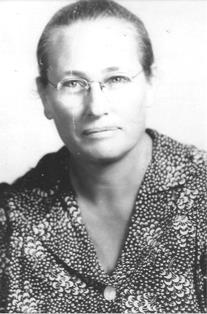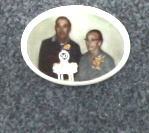Aunt Kate was my dad's sister. Among my fondest memories of growing up in Children's Home was going to her and Uncle Jim's house on Sundays after church and sitting in hide bottom straight chairs with Uncle Jim and their boys in the front yard under the shady oaks. Except for maybe an ornamental bush here and there, the yard around the house was an expanse of cool white sand with no more than an occasional sprig of grass growing in it. Entry to the yard was through a front gate that closed automatically by the weight of a heavy piece of rusty scrap iron suspended from an equally rusty chain stretched between the gate and a post. Often times the gang of boys in the yard in addition to myself included cousins Randolph and Billy Adams, Lloyd Weeks and Arnold "Bootie" Cawthon. Other boys of the community sometimes present were Billy Gordon, Ed Johnson and Frank Mitchell. The Parmer boys themselves were a crowd. They included Melvin, Marvin, Edward, and Hughie. When the rest of us showed up, we totaled close to a dozen. In the summer time, the whole bunch of us would strike out on foot through the woods behind the house for "Week's Wash Hole," about a mile away. It was a swimming hole on the part of Pine Log Creek crossing property once owned by Jeff Weeks whose wife Emmeline Carnley was my great aunt. But more often than not, we would hang out in the yard and just enjoy each other's company and have a good time. The Parmers always had wild animals of one kind or another as pets. For a long period of time, a central feature in the yard was a spacious chicken wire enclosed cage housing one or two grey squirrels whose acrobatic antics were entertaining to watch, and it was not unusual to see one of the kids carrying around a baby flying squirrel.
Uncle Jim loved coon hunting and he had an old ram's horn he used to bugle in the dogs after a night's hunt. He kept it on the top plate of the front porch over the doorsteps. Every now and then, one of his boys would reach up and grab it and blow a big blast or two on it just for amusement. I tried it a few times, but was never able to make a sound as impressive as they did with it.
The Parmer home was a small wood frame house with a tin roof and walls of unpainted grey weathered heart pine boards. As I recall, the foundation sat on blocks of lighter wood and it had a front porch, a living room with a fireplace on the hearth of which sat a couple of flat irons, a kitchen with a wood burning stove, and a couple of bed rooms. Cracks between the boards in the wall in winter were sometimes covered with pieces of card board boxes or newspapers to keep out the cold air. A small porch outside the back kitchen door held a waist-high shelf on which a wash pan, water bucket and dipper were kept. In the back yard, there was a smoke house, a fig tree and grapefruit tree. When the figs were in season I remember standing under the tree and eating my fill of them. The grapefruit tree made a lot of fruit too but only for a few years. It was extremely sensitive to cold and if not protected from it, would die. Uncle Jim managed to keep it alive by enclosing it with panels of card board, or whatever materials he had available, erected on four posts surrounding the tree. That kept the cold from damaging it for many winters, but it eventually grew so big and tall that it could no longer be shielded and one freezing night it got colder than the tree could stand and it died.
Uncle Jim also kept bees. On one occasion, I remember him donning his protective clothing of long sleeves, a net over his hat and head and gloves to go out and rob the hives. His hives, which he called bee gums, were hollowed sections of tree trunks about two or three feet tall with boards laid over the tops. He smoked the hives with a smoker filled with smoldering rags that sedated the bees making them less inclined to sting. He removed the tops and took out the honey combs and put them in a wash tub. He put the tub in the front yard and we sat around it fishing out the combs and sucking the sweet honey from them and chewing the wax. That was the day I first learned that bee families included drones, which are the male bees and are harmless because they don't sting.
Uncle Jim and Aunt Kate never seemed to mind having a crowd at their home on those Sundays. They were always gracious and hospitable and because of that, I will always warmly remember them and treasure the brief time they were a part of my life.
Sam Carnley
24 September 2017
Aunt Kate was my dad's sister. Among my fondest memories of growing up in Children's Home was going to her and Uncle Jim's house on Sundays after church and sitting in hide bottom straight chairs with Uncle Jim and their boys in the front yard under the shady oaks. Except for maybe an ornamental bush here and there, the yard around the house was an expanse of cool white sand with no more than an occasional sprig of grass growing in it. Entry to the yard was through a front gate that closed automatically by the weight of a heavy piece of rusty scrap iron suspended from an equally rusty chain stretched between the gate and a post. Often times the gang of boys in the yard in addition to myself included cousins Randolph and Billy Adams, Lloyd Weeks and Arnold "Bootie" Cawthon. Other boys of the community sometimes present were Billy Gordon, Ed Johnson and Frank Mitchell. The Parmer boys themselves were a crowd. They included Melvin, Marvin, Edward, and Hughie. When the rest of us showed up, we totaled close to a dozen. In the summer time, the whole bunch of us would strike out on foot through the woods behind the house for "Week's Wash Hole," about a mile away. It was a swimming hole on the part of Pine Log Creek crossing property once owned by Jeff Weeks whose wife Emmeline Carnley was my great aunt. But more often than not, we would hang out in the yard and just enjoy each other's company and have a good time. The Parmers always had wild animals of one kind or another as pets. For a long period of time, a central feature in the yard was a spacious chicken wire enclosed cage housing one or two grey squirrels whose acrobatic antics were entertaining to watch, and it was not unusual to see one of the kids carrying around a baby flying squirrel.
Uncle Jim loved coon hunting and he had an old ram's horn he used to bugle in the dogs after a night's hunt. He kept it on the top plate of the front porch over the doorsteps. Every now and then, one of his boys would reach up and grab it and blow a big blast or two on it just for amusement. I tried it a few times, but was never able to make a sound as impressive as they did with it.
The Parmer home was a small wood frame house with a tin roof and walls of unpainted grey weathered heart pine boards. As I recall, the foundation sat on blocks of lighter wood and it had a front porch, a living room with a fireplace on the hearth of which sat a couple of flat irons, a kitchen with a wood burning stove, and a couple of bed rooms. Cracks between the boards in the wall in winter were sometimes covered with pieces of card board boxes or newspapers to keep out the cold air. A small porch outside the back kitchen door held a waist-high shelf on which a wash pan, water bucket and dipper were kept. In the back yard, there was a smoke house, a fig tree and grapefruit tree. When the figs were in season I remember standing under the tree and eating my fill of them. The grapefruit tree made a lot of fruit too but only for a few years. It was extremely sensitive to cold and if not protected from it, would die. Uncle Jim managed to keep it alive by enclosing it with panels of card board, or whatever materials he had available, erected on four posts surrounding the tree. That kept the cold from damaging it for many winters, but it eventually grew so big and tall that it could no longer be shielded and one freezing night it got colder than the tree could stand and it died.
Uncle Jim also kept bees. On one occasion, I remember him donning his protective clothing of long sleeves, a net over his hat and head and gloves to go out and rob the hives. His hives, which he called bee gums, were hollowed sections of tree trunks about two or three feet tall with boards laid over the tops. He smoked the hives with a smoker filled with smoldering rags that sedated the bees making them less inclined to sting. He removed the tops and took out the honey combs and put them in a wash tub. He put the tub in the front yard and we sat around it fishing out the combs and sucking the sweet honey from them and chewing the wax. That was the day I first learned that bee families included drones, which are the male bees and are harmless because they don't sting.
Uncle Jim and Aunt Kate never seemed to mind having a crowd at their home on those Sundays. They were always gracious and hospitable and because of that, I will always warmly remember them and treasure the brief time they were a part of my life.
Sam Carnley
24 September 2017
Inscription
Wed Jan 1, 1927
Family Members
Sponsored by Ancestry
Advertisement
Advertisement

















